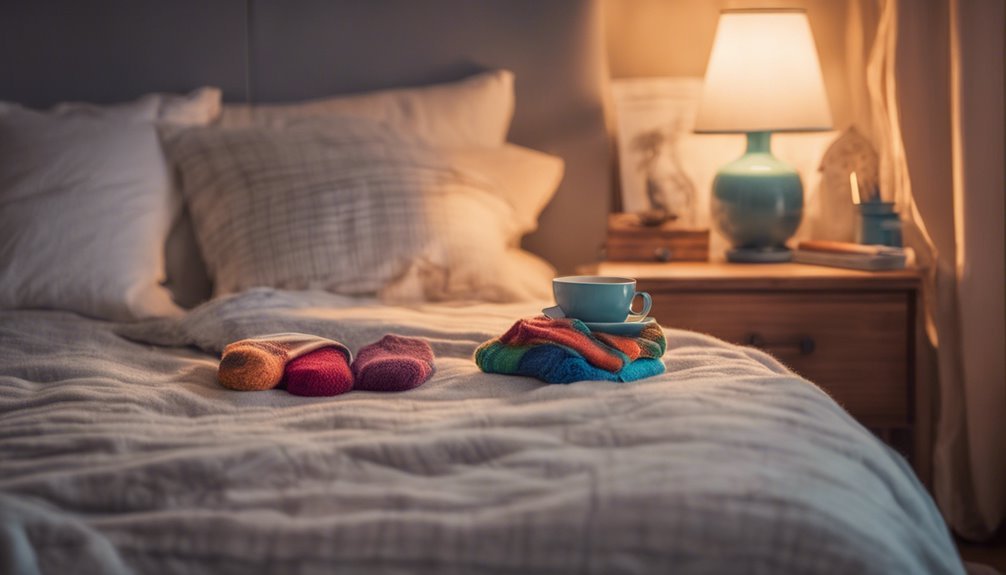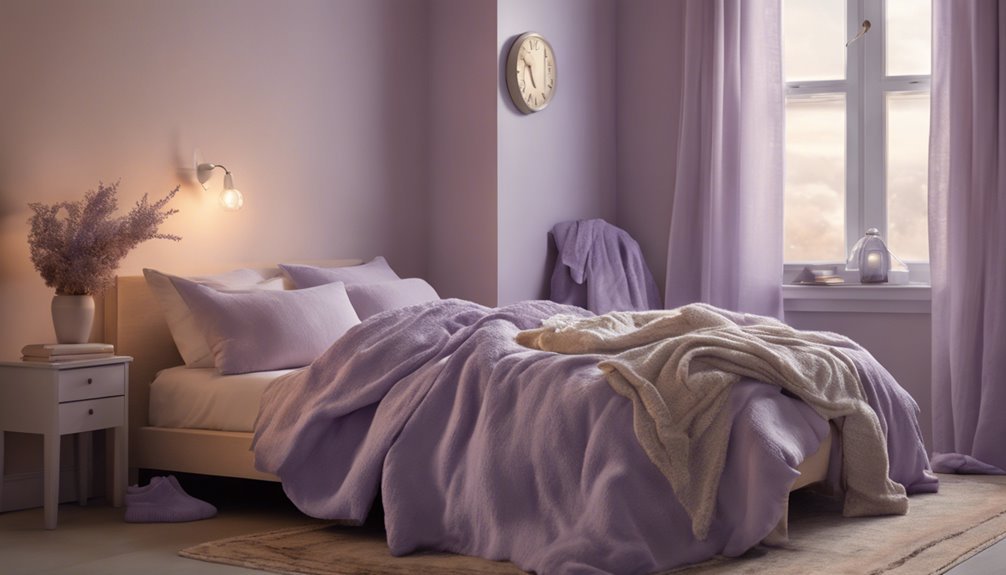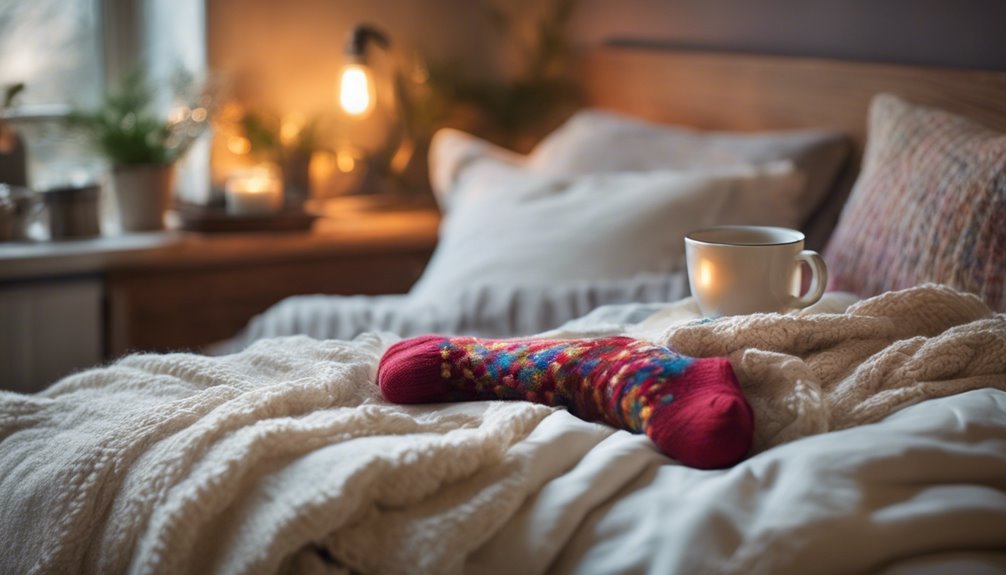Does Wearing Socks to Bed Help You Sleep Better?
Wearing socks to bed can help improve your sleep quality by regulating body temperature and enhancing circulation. Keeping your feet warm promotes vasodilation, which signals your brain to relax and prepares you for deeper sleep stages. Moisture-wicking materials prevent discomfort while keeping your feet cozy. By creating a comfortable sleep environment, you may reduce disturbances caused by cold feet. Interested in finding the perfect socks for a restful night? There's more to explore on creating your ideal sleep setup.
The Science of Sleep: How Temperature Affects Rest

When you sleep, your body's temperature regulation plays an essential role in achieving restful slumber. Your sleep cycles are influenced by how well your body maintains thermal comfort. As you shift through different stages of sleep, your core temperature naturally decreases. If your environment is too hot or too cold, it can disrupt these cycles, preventing you from reaching deeper, restorative sleep. Maintaining a suitable temperature allows your body to enter and sustain the necessary stages of sleep, enhancing overall sleep quality. This balance is vital for promoting relaxation and reducing nighttime awakenings. By understanding the science of temperature regulation, you can create a sleep environment that fosters freedom and comfort, ultimately leading to a more rejuvenating rest.
Benefits of Wearing Socks to Bed
Although some may dismiss the idea of wearing socks to bed as mere comfort, research indicates that this simple practice can markedly enhance your sleep quality. By keeping your feet warm, you promote vasodilation, which can help regulate your body temperature. This regulation is essential for achieving deep sleep stages. Additionally, the right sock materials, such as wool or cotton, can wick away moisture, preventing discomfort that might disrupt your rest. When your feet are cozy, it fosters an overall sense of sleep comfort, allowing you to drift off more easily. So, if you're seeking a straightforward way to improve your nightly routine, consider slipping on some socks—your sleep experience might just benefit greatly from this small change.
Improved Circulation and Its Impact on Sleep Quality
Wearing socks to bed can greatly enhance blood flow, which is essential for overall body function during sleep. Improved circulation helps regulate your body temperature, creating a more comfortable sleep environment. As a result, you may experience better sleep quality, leading to more restorative rest.
Enhanced Blood Flow
While many may overlook the impact of wearing socks to bed, it can considerably enhance blood flow, thereby improving overall circulation during sleep. When your feet are snug and warm, it encourages vasodilation, the process where blood vessels widen, promoting better blood flow to extremities. This improvement can have a ripple effect, leading to reduced discomfort and a more restful night. Warm extremities signal to your brain that it's time to relax, contributing to a calming effect that can enhance sleep quality. Additionally, with improved circulation, the body can effectively deliver nutrients and remove waste products, fostering a more restorative sleep experience. So, don't underestimate the potential benefits of simply slipping on a pair of socks before bedtime!
Temperature Regulation Benefits
When you wear socks to bed, it not only keeps your feet warm but also plays an essential role in regulating your body temperature throughout the night. By promoting temperature regulation, socks can help facilitate vasodilation, which enhances blood flow. This improved circulation aids in maintaining a stable core temperature, ultimately contributing to better sleep comfort. When your body temperature is balanced, it reduces the likelihood of disruptions caused by overheating or feeling too cold. As a result, you may experience deeper, more restorative sleep. Consequently, wearing socks can be a simple yet effective strategy for enhancing your overall sleep quality, allowing you to wake up feeling refreshed and ready for the day ahead.
The Psychological Effect of Cozy Sleep Habits
Cozy sleep habits, such as wearing socks to bed, can considerably influence psychological well-being. Engaging in cozy rituals like this can create a sense of security and comfort, which is essential for winding down after a long day. When you adopt bedtime comfort practices, your brain begins to associate these actions with relaxation and sleep readiness, reducing stress and anxiety levels. This psychological conditioning can enhance your overall sleep quality by promoting a tranquil mindset. Furthermore, the familiarity of these routines fosters a positive emotional environment, allowing you to feel more at ease and in control. Ultimately, integrating cozy sleep habits into your nightly routine may lead to improved mental health and a greater sense of well-being.
Choosing the Right Socks for Sleep

Choosing the right socks for sleep can greatly impact your overall comfort and sleep quality. When selecting socks, consider both sock materials and sock thickness to optimize your nighttime experience. Look for:
- Breathable fabrics: Cotton or bamboo are excellent choices to prevent overheating.
- Moisture-wicking properties: Materials like merino wool help keep your feet dry and comfortable.
- Optimal thickness: Thinner socks allow for better temperature regulation, while thicker options provide added warmth.
Finding the perfect balance between warmth and breathability will enhance your sleep environment. The right socks can help maintain your body temperature, contributing to a more restful night. So, don't overlook this subtle yet impactful aspect of your bedtime routine.
Common Myths About Sleeping With Socks
You might have heard that wearing socks to bed can disrupt your body's natural temperature regulation, but this isn't always the case. In fact, socks can help maintain warmth and improve circulation, countering common concerns about blood flow. Let's clarify these myths to better understand how sleeping with socks can affect your rest.
Temperature Regulation Myths
Although many believe that wearing socks to bed disrupts temperature regulation, the reality is more nuanced. Here are a few common temperature misconceptions that you might find interesting:
- Socks cause overheating: Wearing socks can actually help maintain a stable body temperature by keeping your feet warm, which may promote better sleep.
- Your body will adjust poorly: The body is equipped to handle varying temperatures, and wearing socks won't throw off your natural regulation.
- Sock preferences are universal: Everyone's comfort is different; some might thrive with socks, while others prefer to sleep barefoot.
Ultimately, understanding your own sock preferences can enhance your sleep experience rather than hinder it. Embracing what works for you is key to a better night's rest.
Circulation Concerns Explained
While many fear that wearing socks to bed could restrict blood flow and lead to circulation issues, this concern is largely unfounded. In fact, wearing socks can actually enhance circulation by keeping your feet warm, which promotes vasodilation. This process increases blood flow, helping you relax and fall asleep faster. Here's a brief overview of common myths regarding circulation and socks:
| Myth | Reality | Impact on Sleep |
|---|---|---|
| Socks restrict circulation | Socks improve blood flow | Promotes relaxation |
| Cold feet cause circulation issues | Warm feet enhance circulation | Aids in falling asleep faster |
| Tight socks are necessary | Loose-fitting socks are ideal | Guarantees comfort and freedom |
Tips for Creating a Sleep-Friendly Environment
Creating a sleep-friendly environment is essential for promoting restful sleep, as various factors can greatly influence sleep quality. Your bedroom ambiance plays a vital role in your ability to unwind and relax. Here are some tips to enhance your sleep environment:
- Control the temperature: Keep your room cool, ideally between 60-67°F (15-19°C) for ideal sleep.
- Minimize noise: Use earplugs or white noise machines to drown out disruptive sounds.
- Limit light exposure: Block out light with blackout curtains and avoid screens at least an hour before bedtime.
Frequently Asked Questions
Can Wearing Socks to Bed Cause Overheating During Sleep?
In this modern age, you might wonder if wearing socks to bed leads to overheating. While socks can enhance blood circulation, they might raise your sleep temperature, making it harder for some to achieve restful slumber.
Are There Specific Sock Materials Better for Sleeping?
When choosing sock materials for sleep, consider wool for its moisture-wicking benefits and temperature regulation, while cotton offers comfort and breathability. Both options can enhance your sleeping experience, depending on your personal preferences.
How Do Socks Affect Foot Odor While Sleeping?
Socks can influence foot odor during sleep. Proper socks hygiene is essential; breathable materials help with odor prevention by reducing moisture buildup, which fosters bacteria growth. Choosing the right fabric promotes a fresh sleeping environment for your feet.
Can Children Benefit From Wearing Socks to Bed?
Yes, children can benefit from wearing socks to bed. Sock warmth may enhance children's sleep by promoting better circulation and maintaining a comfortable temperature, which can lead to improved rest and overall well-being during their growth.
Is It Safe to Wear Tight Socks While Sleeping?
Wearing tight socks while sleeping can restrict blood circulation, potentially affecting your sleep quality. If you prefer comfort and freedom during sleep, opt for looser socks to promote better circulation and enhance your overall rest.







